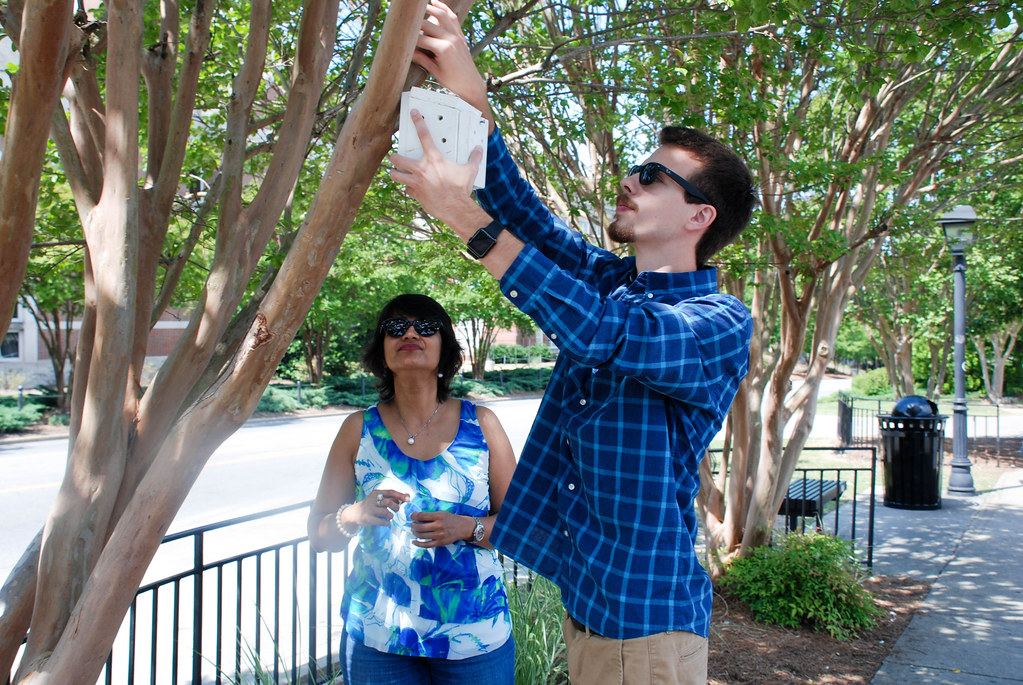Auburn researchers compare heat produced by large and small urban areas
Article body
Scientists have long understood the effect large urban areas like New York City or Atlanta have on temperature – these mega cities are warmer than nearby rural locations due to increased energy usage, the enormous presence of heat-absorbing impervious surfaces like concrete, steel and asphalt, and dwindling green spaces. Scientists refer to these heat-producing urban centers as "urban heat islands." What is less understood is whether smaller urban areas create the same urban heat island effect.
In an effort to shed light on the heat-causing potential of small to mid-sized cities, Chandana Mitra, assistant professor in Auburn University's Department of Geosciences, recently completed a study on whether the Auburn-Opelika and Birmingham areas create enough excess heat to be considered urban heat islands.
"In 2008 we crossed the line between urban and rural, and we now have more people living in urban areas than rural areas," said Mitra. "Urbanization is happening rapidly; it's a global phenomenon. The United Nations forecasts that over 70 percent of the world's population will be living in urban areas by 2050, which is why it is imperative we gather information on how urban heat islands affect local climate change and how we can lessen human discomfort."
Mitra and Andy Hug, a 2014 geography master's graduate and geographic information system specialist for the Georgia-Alabama Land Trust, used 40 iButtons–highly accurate, small digital thermometers that store data–to measure temperature differences in rural and urban locations throughout Birmingham, Opelika and Auburn. They placed 20 iButtons in downtown Birmingham and surrounding rural areas and 20 iButtons in the Auburn-Opelika area including Tiger Town, The Hotel at Auburn University and Dixon Conference Center, Samford Park and various rural locations.
Temperatures were gauged from March 1 to August 31, 2014, and data was then analyzed. They discovered in the Auburn-Opelika area an average 4.39 degree Fahrenheit heat intensity difference between urban and rural areas during the day. Birmingham had an average 3.84 degree Fahrenheit daytime heat intensity difference.
"The reason Birmingham's heat intensity difference was smaller is due to the height/width ratio of the buildings in the Auburn-Opelika area versus Birmingham," explained Mitra. "Downtown Birmingham buildings are taller and the gap between buildings is less, which means there is more shade. In the Auburn-Opelika area there are not many tall buildings and there is a larger space between buildings, which means there is less shade. As a result, during the day the difference in average temperature between rural and urban areas is greater in Auburn-Opelika than it is in Birmingham.
"However, at night the reverse happens. The temperature difference between the urban and rural areas is less in the Auburn-Opelika area because the tall buildings and increased impervious surfaces in downtown Birmingham absorb more heat which is released at night."
Mitra also looked at heat intensity differences during two heat waves.
"There were two high heat spells during our study that occurred continuously for three days. One was from Aug. 6-8 and the other was Aug. 21-23. During these timeframes, the average daytime temperature difference between urban and rural areas in Birmingham was about 11 degrees Fahrenheit. At night it was about 9 degrees Fahrenheit. The Auburn-Opelika average daytime temperature difference between rural and urban areas was 18.92 degrees Fahrenheit, and the nighttime difference was about 7 degrees Fahrenheit."
Mitra notes these numbers are significant because they could spell danger for the most vulnerable members of society, including the elderly, children and those who work outdoors.
"Those living and working in areas that are nearly 10 or more degrees hotter than the high temperature for the day are at a higher risk for emergency health situations," said Mitra. "We can mitigate the effects of urban heat islands by promoting more green space, incorporating verdant rooftops or white rooftops. We can use less energy by adopting solar panels and rainwater catching techniques. All of this contributes to a much cooler, sustainable community and a resilient one, too."
Mitra is working with geography master's student Austin Bush to expand on the results of the urban heat island project. Bush assisted as an undergraduate student at Auburn with the initial study, and he conducted an independent research project in summer 2015 which further verified the results gathered by Mitra and Hug. Now, for his master's thesis project, Bush is developing urban sustainability maps for the cities of Auburn and Opelika. An urban sustainability map provides multiple layers of information including topography, average precipitation, average temperature, where extreme weather most frequently occurs and socioeconomic data such as where people live according to age and average economic status.
Bush will work with Mitra to gather data by utilizing Geographic Information System, or GIS, technology, as well as T-LiDAR equipment. A T-LiDAR is a tripod-mounted laser scanner, also known as terrestrial light detection and ranging, that sends out a laser that scans anything within range and produces a three-dimensional replica.
"We will also evaluate which rooftops have the greatest potential for harvesting rainwater and which locations would benefit from using solar panels, and we will evaluate the cost versus savings for both," said Bush. "The maps will show us where people are most vulnerable, which part of the city is most comfortable, and can serve to inform future planning decisions. The ultimate goal is for a person to simply type in their address on a website and receive information about and suggestions for their location."
For more information on Mitra, visit her website at www.auburn.edu/cosam/mitra.
Related Media
Media interested in this story can contact Communications Director Preston Sparks at (334) 844-9999 or preston.sparks@auburn.edu.
Auburn University is a nationally ranked land grant institution recognized for its commitment to world-class scholarship, interdisciplinary research with an elite, top-tier Carnegie R1 classification, life-changing outreach with Carnegie’s Community Engagement designation and an undergraduate education experience second to none. Auburn is home to more than 30,000 students, and its faculty and research partners collaborate to develop and deliver meaningful scholarship, science and technology-based advancements that meet pressing regional, national and global needs. Auburn’s commitment to active student engagement, professional success and public/private partnership drives a growing reputation for outreach and extension that delivers broad economic, health and societal impact.









